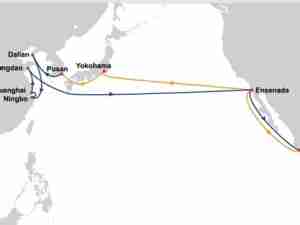The ports of Long Beach and Los Angeles have implemented an incentive program aimed at accelerating the use of cleaner-burning fuel by ocean vessel operators when transiting within 40 nautical miles of the San Pedro Bay and while at berth in either port. With this program, launched July 1, 2008, sulfur oxides (SOx), which contribute to the formation of health-threatening soot or particulate matter, will be cut by as much as 11 percent and particulate matter (PM) by 9 percent, with the projected participation of 50 percent of the ships calling at the two ports.
The ports have earmarked nearly $20 million to pay vessel operators to use cleaner-burning, low-sulfur fuel in their main propulsion engines. Under the program, the ports will pay the difference between the price of bunker fuel and more costly low-sulfur fuel - marine gas oil with no more than 0.2 percent sulfur. To expand fuel availability, both ports have taken preliminary steps to amend their tariffs and also allow the use of marine diesel oil with no more than 0.2 percent sulfur.
"We congratulate the carriers that are voluntarily participating in this program, and we urge all of our lines to join in improving air quality," said Long Beach Harbor Commission President James C. Hankla. "This program will give us significant improvements in air quality and provide a much-needed bridge to the important state regulations on low-sulfur fuels that will start next year."
As of July 10, 13 carriers at the two ports had enrolled in the incentive program: Carnival Cruise Line, CMA CGM, Evergreen Marine, Great American Lines, Hapag Lloyd, Hyundai Merchant Marine, Maersk, Magical Cruise Co. (Disney), Norwegian Cruise Line, NYK - PCC Division, Orient Overseas Container Line (OOCL), Prestige Cruises, and Toyofuji Shipping. These carriers have enrolled a total of 123 vessels that are scheduled to make 260 port calls during each quarter or three-month period.
"On the first day of this program, we had more than 100 ships committed to using cleaner fuel in their engines - that alone shows the partnership both ports have forged with our customers in the mission to move forward in cleaning up operations on all fronts," said Los Angeles Harbor Commission President S. David Freeman.
With the incentive program, the ports want all ships to switch from highly polluting bunker fuel, which generates the majority of sulfur oxide emissions in Southern California and makes ocean-going vessels the single largest source of air pollution at the two ports - accounting for about half of the port-relation pollution.
To qualify for the port incentive program, vessel operators agree to switch to low-sulfur fuel within at least 20 miles -- and as far as 40 miles -- from the ports. Vessels also are required to use low-sulfur fuel in their auxiliary engines while at berth in the port complex. To qualify for the incentive program, the ships must also participate in the ports' voluntary Vessel Speed Reduction Program, limiting speeds to 12 knots during the switch to low-sulfur fuel. Most ships already participate in the speed reduction program, which also curbs emissions.
The incentive program is expected to cost the Port of Los Angeles as much as $8.6 million and the Port of Long Beach as much as $9.9 million annually. The one-year program will expire June 30, 2009, unless extended by the two commissions.
On July 1, 2009, a pending California Air Resources Board regulation would require the use of low-sulfur fuel in cargo vessels' main propulsion engines within 24 nautical miles of the state's coast. The San Pedro Bay Ports Clean Air Action Plan also calls for the ports to accelerate ship-emission reductions by including lease-based limits on sulfur content in fuel. This is still planned. The incentive program is aimed at reducing more emissions on an even faster schedule.





